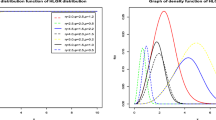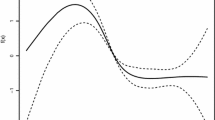Abstract
A competing risks situation where a potential critical unit failure at random time \(X_2\) in a life test may be avoided by observing a degraded failure at some random time \(X_1\) is considered. It is thus logical to expect a dependence between the event times \(X_1\) and \(X_2\). We model the joint distribution of \(X_1\) and \(X_2\) by the Frank copula because it captures the full range of dependence and it is symmetric in its dependence structure. This paper shows how expert opinion is used to estimate the assumed Frank copula when only incomplete competing risks data are observed. Estimation of the copula allows the marginal distributions to be identified from competing risks data. Our result is thus apparent in reliability where primary interest is in the estimation of marginal failure distributions and can be extended to other applications.



Similar content being viewed by others
References
Basu A, Ghosh J (1978) Identifiability of the multinormial and other distribuions under competing risks model. J Multivar Anal 8:413–429
Bedford T, Cooke RM (2001) Probabilistic risk analysis: foundations and methods. Cambridge University Press, Cambridge
Bunea C, Bedford T (2002) The effect of model uncertainty on maintenance optimization. IEEE Trans Reliab 51(4):486–493
Bunea C, Mazzuchi TA (2007) Accelerated life tests: analysis with competing failure modes. In: Ruggeri F, Kenett RS, Faltin FW (eds) Encyclopedia of statistics in quality and reliability. Wiley, England, pp 30–43
Carriere JF (1994) Dependent decrement theory. Trans Soc Actuar 46:45–65
Chen Y (2010) Semiparametric marginal regression analysis for dependent competing risks under an assumed copula. J R Stat Soc 72:235–251
Clemen RT, Fischer GW, Winkler RL (2000) Assessing dependence: some experimental results. Manag Sci 46:1100–1115
Conover WJ (1999) Practical nonparametric statistics. Wiley, New York
Cooke RM (1991) Experts in uncertainty. Oxford University Press, Oxford
Cooke R (1996) The design of reliability databases, part II: competing risk and data compression. Reliab Eng Syst Saf 51:209–223
Cooke R, Bedford T (2002) Reliability databases in perspective. IEEE Trans Reliab 51(3):294–310
Cooke RM, Goossens LHJ (2000) Procedures guide for structured expert judgement in accident consequence modelling. Radiat Prot Dosim 90(3):303–309
de Una-Alvarez J, Veraverbeke N (2013) Generalised copula-graphic estimator. Test 22:343–360
Dijoux Y, Gaudoin O (2009) The alert-delay competing risks model for maintenance analysis. J Stat Plan Inference 139(5):1587–1603
Dimitrova DS, Haberman S, Kaishev VK (2013) Dependent competing risks: cause elimination and its impact on surviaval. Insur Math Econ 53:464–477
Escarela G, Carriere JF (2003) Fitting competing risks with an assumed copula. Stat Methods Med Res 12:333–349
Genest C (1987) Frank’s family of bivariate distributions. Biometrika 74:549–555
Gigerenzer G (1991) How to make cognitive illusions disappear: beyond heuristics and biases. Eur Rev Soc Psychol 2:83–115
Gigerenzer G, Hoffrage U, Kleinbolting H (1991) Probabilistic mental models: a Brunswikian theory of confidence. Psychol Rev 83:506–528
Han D, Balakrishnan N (2010) Inference for a simple step-stress model with competing risks for failure from the exponential distribution under time constraint. Comput Stat Data Anal 54:2066–2081
Kaishev VK, Dimitrova DS, Haberman S (2007) Modelling the joint distribution of competing risks survival times using copula functions. Insur Math Econ 41:339–361
Lindqvist BH, Skogsrud G (2009) Modeling of dependent competing risks by first passage times of Wiener processes. IIE Trans 41:72–80
Ling CH (1965) Representation of association functions. Publ Math Debr 12:189–212
Lo SMS, Wilke RA (2010) A copula model for dependent competing risks. J R Stat Soc 59(2):359–376
Meeker WQ, Escober LA, Hong Y (2009) Using accelerated test results to predict product field reliability. Technometrics 51(2):146–161
Nelsen RB (2006) An introduction to copulas. Springer, New York
Rivest LP, Wells MT (2001) A martingale approach to the copula-graphic estimator for the survival function under dependent censoring. J Multivar Anal 79(1):138–155
Schweizer B, Sklar A (1983) Probabilistic metric spaces. North-Holland, New York
Sklar A (1973) Random variables, joint distribution functions, and copulas. Kybernetika 9(6):449–460
Tsiatis A (1975) A nonidentifiability aspect of the problem of competing risks. Proc Natl Acad Sci USA 27(1):20–22
Wu M, Shi Y, Zhang C (2015) Statistical analysis of dependent competing risks model in accelerated life testing under progressively hybrid censoring using copula function. Commun Stat Simul Comput 1–38. doi:10.1080/03610918.2015.1080836
Xu A, Tang Y (2011) Objective Bayesian analysis of acclerated competing failure modes under type-I cencoring. Comput Stat Data Anal 55:2830–2839
Zhang XP, Shang JZ, Chen X, Zhang CH, Wang YS (2014) Statistical inference of accelerated life testing with dependent competing failures based on copula theory. IEEE Trans Reliab 63(3):764–780
Zheng M, Klein JP (1995) Estimates of marginal survival for dependent competing risks based on an assumed copula. Biometrika 82(1):127–138
Acknowledgements
We would like to thank the anonymous referees for their comments and suggestions which improved the paper considerably.
Author information
Authors and Affiliations
Corresponding author
Appendix 1
Appendix 1
The R code for assessing concordance probability and generating an estimated value of Kendall’s \(\tau\).

Rights and permissions
About this article
Cite this article
Hove, H., Beichelt, F. & Kapur, P.K. Estimation of the Frank copula model for dependent competing risks in accelerated life testing. Int J Syst Assur Eng Manag 8, 673–682 (2017). https://doi.org/10.1007/s13198-016-0548-6
Received:
Revised:
Published:
Issue Date:
DOI: https://doi.org/10.1007/s13198-016-0548-6




